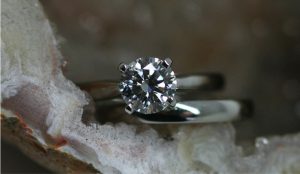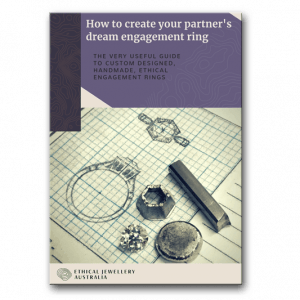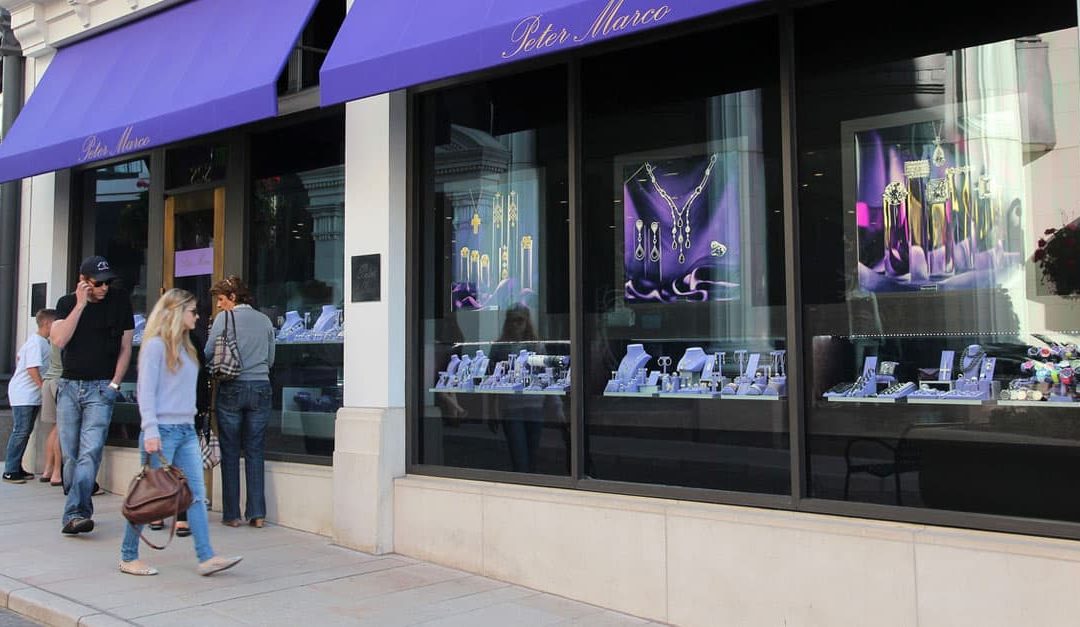If you’re interested in diamonds and diamond jewellery, it’s very likely you’ve seen the slogan “Real is Rare”. It was the centerpiece of the diamond mining industry’s most recent awareness campaign that now often shows up as a hashtag.
It popped up again just recently attached to an article about lab-grown diamonds. And I have to admit it annoyed me somewhat.
As the operator of a customer-facing, ethical jewellery business, I have a couple of concerns with this slogan and how it’s being bandied about (as I’ll explain in a moment).
Let me say up front though, for the most part I don’t have a problem with mined diamonds so long as they are ethically produced and cut.
If the people connected to the supply chain are treated well and appropriately remunerated and steps are taken by producers to reduce their carbon footprint and make good the unavoidable environmental damage they do, then I’m okay with it.
Sadly however, mined diamonds meeting these criteria are few and far between.
Of course, mined diamonds will be around for a while yet and a lot of people love them regardless of their sometimes-questionable provenance, so we’re kinda stuck with them anyway.
Now, back on point …
My first problem with Real is Rare tag line is with the word ‘real’.
Real is rare?
Frankly, this slogan could easily be construed as misleading.

A real lab-grown diamond, ironically perhaps more rare than an equivalent mined diamond at this point in time – given lab-grown diamonds constitute only 5% of the global diamond supply (Antwerp World Diamond Center, 2018)
It doesn’t take too much imagination to conclude that by ‘real’ the mining industry promoters mean ‘mined’. After all, the campaign was clearly a move against the competitive threat posed by the lab-grown diamond industry.
The inference embedded in the Real is Rare slogan is that any diamond that originates by any means other than through mining is not ‘real’.
This plainly isn’t true.
The fact is, as confirmed by the United States’ Federal Trade Commission (FTC) in 2018, lab-grown diamonds are also real diamonds (just produced in a different way).
Now, to be generous, the Real is Rare campaign came out before the FTC made its ruling. But the mined diamond industry continues to benefit from a piece of creative advertising that is no longer technically correct.
What it should say is: #mined-diamonds-are-rare. But that doesn’t quite have the same ring to it does it?
Which brings me to my second problem:
What qualifies as ‘rare’?
Let me quote you some statistics.
According to Bain & Company’s Global Diamond Industry Report 2018, total rough diamond production in 2017 amounted to 151 million carats. The total for 2018 is estimated to be 147 million carats. And for the four preceding years (2013 – 2016) annual production averaged at around 127 million carats.
In other words, approximately 806 million carats of rough diamonds were produced by the mining industry in the past six years.
Of course, a large percentage of those are only suitable for industrial applications. In fact, according to the Gemmological Institute of America (GIA) 2015, just 30% of rough diamonds are of jewellery quality.
That means that only 240 million carats worth of total production over the past six years was suitable for use in jewellery.
Divide that by six and you get an annual production of around 40 million carats.
40 million carats of jewellery-grade diamonds produced per annum
To my mind, 40 million of anything doesn’t sound particularly rare, especially when that’s the amount being produced year on year.
Of course, the global market for diamonds is quite large, so it’s probably true to say that supply is limited relative to demand. But that doesn’t carry the same inference of value as does ‘rare’.
Pandas are rare.
Blue Macaws are rare.
Issue #1 Superman comics are rare.
Diamonds? Maybe not so much?
Of course, some diamonds really are rare
There’s no question that some diamonds are indeed very uncommon. Multi-carat, low colour, high clarity whites, vivid pinks and yellows and reds and blues are all extremely rare.
Only a handful are found and released to market each year and their mind-boggling sale prices reflect how truly remarkable they are.
But to make the blanket statement that all (mined) diamonds are rare is, to put it nicely, a bit of a stretch.
Take a walk through any diamond district around the world or any significant jewellery retail precinct and take note of how many diamonds are in the jewellery shop windows. There are vast numbers of them.
None of this is to say the average diamond isn’t worth much. That’s not the case because there’s a lot more tied up in the value of diamonds than simply the number of them that exist.
The supply chain is long, labour and capital intensive and many very skilled hands touch the diamonds that make it to market. And their price reflects, to a large extent, just how difficult it is to get them out of the ground and into a piece of jewellery.
By the way, there is another kind of diamond that’s rare
Of course, I did more than just hint at this up front. There is another kind of diamond that’s rare, and that’s the ethically produced kind.
Anyone who has had to source diamonds of an unusual shape or above a certain size or grade will appreciate just how few ethically produced mined diamonds there are on the market at any given point in time.
And let’s get one thing straight, just because a diamond can be traced back to its origin, that, on its own, does not automatically make for an “ethical” diamond.
Traceability is not enough. (Though it’s a good start.)
What constitutes an ‘ethically produced diamond’?
This is where things get complicated, because ‘ethical’ is subjective.
What’s ethical to you may not be ethical to me.
For instance, those with a social conscience will advocate for Artisanal Small-scale Mining (ASM) because of the economic support it offers to many communities that have no other substantial means of generating income.
On the other hand, those who advocate for the environment have a hard time accepting that any mining is good.
Most people sit somewhere in between those two extremes, but both camps I’m sure can agree that a lot of things about the industry as it is today are not okay.
Slave, indentured and child labour in the industry is not okay.
Exploitation in the diamond cutting industry is not okay.
Poor workplace health and safety standards in both ASM and the cutting and polishing industry is not okay.
Conflict funding is not okay.
Habitat destruction and land degradation without rehabilitation is not okay.
Corruption, smuggling and money laundering is not okay.
Leaving greenhouse gas emissions unchecked is not okay.
If something is to be classed as having been ‘ethically produced’ then, by our standards at least, it cannot be associated with any of the above.
The future looks promising
Despite all the negatives, it’s fair to say things are improving.
The jewellery industry (of which the diamond sector is a sub-set) is under considerable pressure to reform.
Some of that pressure comes from thought leaders inside the industry. Some of it comes from thought leaders from the outside. And some of it happens simply because it makes good business sense.
The cynic in me is inclined to think it’s the latter motivator – money – that’s forcing the greatest amount of change.
Hardly a day goes by when someone doesn’t mention the business opportunity presented by catering to the so-called ‘discerning Millennial’ market. And when money talks, people listen.
The fact of the matter is most of the large jewellery manufacturers and diamond and gemstone wholesalers could’ve started offering ethical products years, even decades ago if they’d had the willpower, conscience and foresight. Yet very few did.
Of course, now that there’s so much momentum in the marketplace, suddenly we’re seeing shifts towards more responsible offerings (and we’re also seeing PR machines kicking into action).
Disappointingly, most of the time it’s the profit motive that prevails. But hey, if it means things get better, I’ll take the win.
About EJA
Ethical Jewellery Australia is an online engagement and wedding ring specialist. Every ring is custom designed and made to order.
We take our customers through the whole process from design to sourcing and finally to manufacturing.
All rings are handmade in Australia with recycled metals. (We can also supply Fair Trade gold if requested.)
Likewise, we only every use ethically sourced diamonds and gemstones. You can choose from Argyle, recycled, vintage and lab-grown diamonds, Australian, US, Fair Trade, recycled and lab-grown coloured gemstones.
By the way, we offer an Australia-wide service.
 If you would like to learn how to start your engagement ring design adventure, get in touch today.
If you would like to learn how to start your engagement ring design adventure, get in touch today.
Or if you’d like to start by learning more about designing an engagement ring, download a free copy of our 70+ page design guide.
About the Author: Benn Harvey-Walker
 Benn is a Co-founder of Ethical Jewellery Australia and a keen student of ethical and sustainability issues in the jewellery world. He has a long history in sales and marketing and began working with EJA full time in early 2018.
Benn is a Co-founder of Ethical Jewellery Australia and a keen student of ethical and sustainability issues in the jewellery world. He has a long history in sales and marketing and began working with EJA full time in early 2018.
Benn co-authored the original Engagement Ring Design Guide in 2014 and edited the 2nd Edition in 2018. He is also the principal author of our wedding and commitment ring design guide.
His main responsibilities at EJA are business development and sales process management. Benn also creates technical drawings for our ring designs.


Recent Comments